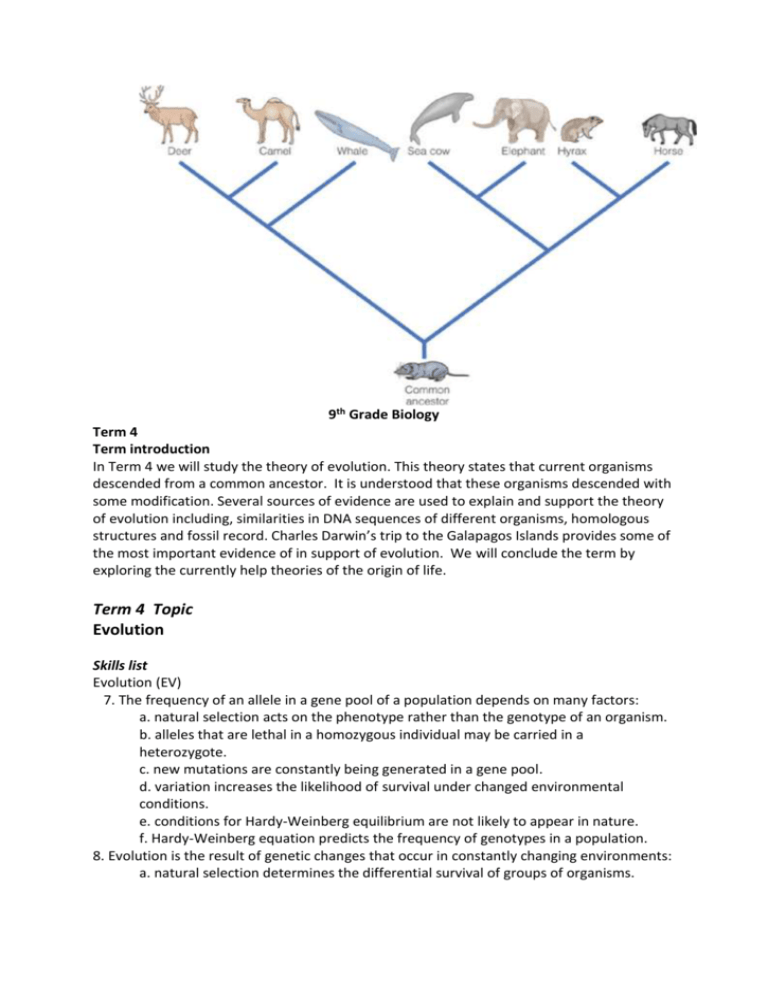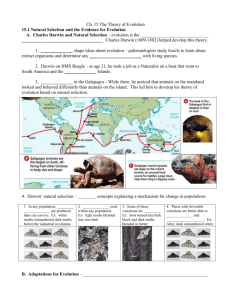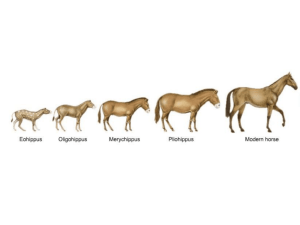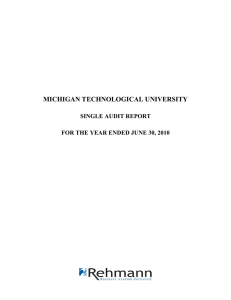
9th Grade Biology
Term 4
Term introduction
In Term 4 we will study the theory of evolution. This theory states that current organisms
descended from a common ancestor. It is understood that these organisms descended with
some modification. Several sources of evidence are used to explain and support the theory
of evolution including, similarities in DNA sequences of different organisms, homologous
structures and fossil record. Charles Darwin’s trip to the Galapagos Islands provides some of
the most important evidence of in support of evolution. We will conclude the term by
exploring the currently help theories of the origin of life.
Term 4 Topic
Evolution
Skills list
Evolution (EV)
7. The frequency of an allele in a gene pool of a population depends on many factors:
a. natural selection acts on the phenotype rather than the genotype of an organism.
b. alleles that are lethal in a homozygous individual may be carried in a
heterozygote.
c. new mutations are constantly being generated in a gene pool.
d. variation increases the likelihood of survival under changed environmental
conditions.
e. conditions for Hardy-Weinberg equilibrium are not likely to appear in nature.
f. Hardy-Weinberg equation predicts the frequency of genotypes in a population.
8. Evolution is the result of genetic changes that occur in constantly changing environments:
a. natural selection determines the differential survival of groups of organisms.
b. diversity of species increases the chance that some organisms survive changes in
the environment.
c. genetic drift affects diversity of organisms in a population.
d. reproductive or geographic isolation affects speciation.
e. fossil evidence are analyzed for biological diversity, episodic speciation, and mass
extinction.
f. cladogram shows probable evolutionary relationships.
g. molecular clocks help to estimate how long ago various groups of organisms
diverged evolutionarily from one another.
Investigation and Experimentation (IE)
10. Scientific progress is made by asking meaningful questions and conducting careful
investigations:
a. Select and use appropriate tools and to perform tests, collect data, analyze
relationships, and display data.
b. Identify and communicate sources of unavoidable experimental error.
c. Identify possible reasons for inconsistent results, such as sources of error.
d. Formulate explanations by using logic and evidence.
e. Solve scientific problems by using quadratic equations and simple trigonometric,
exponential, and logarithmic functions.
f. Distinguish between hypothesis and theory as scientific terms.
g. Recognize the usefulness and limitations of models and theories
h. Read and interpret topographic and geologic maps.
i. Analyze the locations, sequences, or time intervals that are characteristic of natural
phenomena
j. Recognize the issues of statistical variability and the need for controlled tests.
k. Recognize the cumulative nature of scientific evidence.
l. Analyze situations and solve problems by applying concepts from more than one
area of science.
m. Investigate a science-based societal issue by researching the literature, analyzing
data, and communicating the findings.
n. when an observation does not agree with an accepted scientific theory, the
observation is sometimes mistaken
Essential questions
How does information flow from DNA to RNA to direct the synthesis of proteins?
How does RNA differ from DNA?
How does the cell make RNA?
What was Charles Darwin’s contribution to science?
What three patterns of biodiversity did Darwin note?
What did Hutton and Lyell conclude about Earth’s history?
How did Lamarck propose that species evolve?
What was Malthus’s view of population growth?
Under what conditions does natural selection occur?
How do fossils help to document the descent of modern species from ancient
ancestors?
What do homologous structures and similarities in embryonic development suggest
about the process of evolutionary change?
How is evolution defined in genetic terms?
What are the sources of genetic variation?
How are DNA sequences used in classification?
What characteristics do all primates share?
What is the goal of evolutionary classification?
What is a cladogram?
Reference Materials
Levine, J. and Miller, K. Biology. (2010: Pearson, Prentice Hall, New Jersey)
(Textbook and Study Workbook)
Day-by-Day
Day 1-2: Charles Darwin
Goal: Learn about Charles Darwin’s contribution to science.
Activity:Charles Darwin’s trip to the Galapagos Islands
Standards: Evolution is the result of genetic changes that occur in constantly
changing environments (8.a-d)
Essential Question: What was Charles Darwin’s contribution to science?
Day 3-4: Biodiversity
Goal: Understand the patterns of biodiversity
Activity: In class worksheet activity
Standards:The frequency of an allele in a gene pool of a population depends on
many factors: (7.d, e)
Essential Question: What three patterns of biodiversity did Darwin note?
Day 5-6: History of life on Earth
Goal: understand Hutton and Lyell’s conclusions about the conditions of early Earth
Activity: Video and worksheet
Standards: Scientific progress is made by asking meaningful questions and
conducting careful investigations (10.a-n)
Essential Question: What did Hutton and Lyell conclude about Earth’s history?
Day 7: Quiz#, Speciation
Goal: Understanding the fundamentals of evolution
Activity:speciation worksheet activity
Standards: Standards:The frequency of an allele in a gene pool of a population
depends on many factors (7a-f)
Essential Question: How did Lamarck propose that species evolve?
Day 8: Population Growth
Goal: Learn about factors that limit population growth
Activity: Graph and chart activity.
Standards: The frequency of an allele in a gene pool of a population depends on
many factors (7a-f)
Essential Question: What was Malthus’s view of population growth?
Day 9: Natural Selection
Goal: Natural selection is the underlying cause of evolution
Activity: Lab Activity, Natural Selection
Standards: Scientific progress is made by asking meaningful questions and
conducting careful investigations (10.a-n)
Essential Question: Under what conditions does natural selection occur?
Day 10: Fossils
Goal: Understand how fossils help document history of life on earth
Activity: Radiometric Dating
Standards: Evolution is the result of genetic changes that occur in constantly
changing environments (8.a-d)
Essential Question: How do fossils help to document the descent of modern
species from ancient ancestors?
Day 11: Quiz #2
Day 12: Homologues Structures
Goal: Learn how homologous structures in different species support evolution
Activity: Lecture, video and solving multiple choice questions.
Standards:The frequency of an allele in a gene pool of a population depends on
many factors (7a-f)
Essential Question: What do homologous structures and similarities in embryonic
development suggest about the process of evolutionary change?
Day 13: Microevolution
Goal:Learn how Genetics can help explain evolution
Activity: Lab Activity; Genetic and evolution lab
Standards: Standards:Evolution is the result of genetic changes that occur in
constantly changing environments (8.a-d). Scientific progress is made by asking
meaningful questions and conducting careful investigations (10.a-n)
Essential Question: How is evolution defined in genetic terms?
Day 14: Selective Breading
Goal: Learn how specific trains can be artificially selected
Activity: Selecting for desirable traits in selective breading
Standards:Evolution is the result of genetic changes that occur in constantly
changing environments (8.a-d)
Essential Question: What are the sources of genetic variation?
Day 15: Human Inheritance
Goal: Learn how a cladogram and a Pedigree can help us understand heredity
Activity: Taxonomy Lab Activity
Standards:Evolution is the result of genetic changes that occur in constantly
changing environments (8.a-d). Scientific progress is made by asking meaningful
questions and conducting careful investigations (10.a-n)
Essential Question: What is the goal of evolutionary classification?
Day 16: Quiz #3
Day 17: Viruses
Goal: Understand Viruses and how they infect animals and plants
Activity: Viruses work sheet
Standards: The frequency of an allele in a gene pool of a population depends on
many factors (7a-f)
Essential Question: What is a virus?
Day 18: Project Presentation
Grading breakdown:
Quizzes:
Lab:
Homework
Project
Final
Participation
20%
30% (10% pre-lab and 20% Lab report/activity)
10%
10%
20%
10%
Term 4 Biology Project.
Working in groups of 2, design an original model of any biological system, macromolecules
or molecules that have been covered during the past 3 terms. Be sure to follow the
scientific method in your design and presentation.
You need to get your model topic approved by March 17 th 2015
Project Rubric
Evidence of weekly progress 50%
-write down 2 or more paragraphs of what you did as part of your project during the past
week
-Show pictures of your research work
Final Presentation 50%
Lab Report Outline and Rubric
Name
Partner’s Name
Class/Section
Date
Title of Lab Report
Introduction:
Background information from note book, class notes, text, etc. – Try to tie it together
Key concepts, terms
Purpose of lab activity (20 points)
Materials:
List of key materials that you used during the activity (5 points)
Methods:
A brief, numbered list of steps as to what you completed in the lab
No results should be placed here (5 points)
Results:
Should be presented in a neat, concise and orderly fashion
Data tables in lab manual should be recreated and placed here. Each table should be
numbered and have an appropriate label and title
Include appropriate units
No interpretations should be placed here
Percent Error and mathematical calculations should appear here when necessary (10 points)
Discussion:
What did the lab results show? What were some of your thoughts/hypotheses when this
activity started? Were they validated? Explain using examples. Did this have a tie in with
what was being discussed in class? Was the purpose accomplished? Reasons for error?
(20 points)
Works Cited
Cite all the sources you used in your report. (10 points)
Questions must be Typed and Answered Correctly (30 points)
Homework
All homework must have a name, date and class (A, B or C). It is a point deduction for each
missing item.
Homework is due on Tuesday during Lab.
Late homework will only be accepted up to a week after due date.
Late homework will be accepted but with a 10% deduction.
Text Book Homework
Evolution of
Populations
Classification
Viruses and
Prokaryotes
Assessment Homework and Quizzes
Pages
Due date
Assessment
March 17
17.1, 17.2,17.3
and 17.4
March 23/24
Assessment
April 07
18.1, 18.2 and
18.3
April 13/14
Assessment
April 21
20.1, 20.2 and
20.3
April 27/28
April 30-May 01
May 04
Quizzes
Quiz 1
Quiz 2
Quiz 3
Project Presentation
Final Assignment Due
Science Skills:
1. Observing - using your senses to gather information about an object or event. It is
description of what was actually perceived. This information is considered qualitative
data.
2. Designing Experiments and Constructing Models–using acquired information from
observations to design a scientific experiment and constructing models.
3. Testing Hypotheses- formulating a testable hypothesis using “if/then” statements or
other similar statements
4. Measuring - using standard measures or estimations to describe specific dimensions of
an object or event. This information is considered quantitative data.
5. Inferring - formulating assumptions or possible explanations based upon observations.
6. Classifying - grouping or ordering objects or events into categories based upon
characteristics or defined criteria.
7. Predicting - guessing the most likely outcome of a future event based upon a pattern of
evidence.
8. Communicating - using words, symbols, or graphics to describe an object, action or
event.











